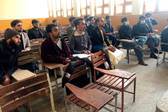The Islamic State in Khorasan's Evolving Strategy
STRIVE Afghanistan Practitioner Summary
After suffering a string of major defeats in 2019 and 2020, the Islamic State in Khorasan (IS-K) was well past its peak in August 2021 when the Taliban seized control of Afghanistan. Although IS-K continued to carry out terror attacks in Kabul and targeted assassinations in Jalalabad during the first half of 2021, the group primarily concentrated on avoiding its enemies.
Despite the Taliban initially discounting IS-K as a serious threat when they took power, the group was able to intensify its activities from the late summer of 2021 onwards. This included an attempted IS-K guerrilla campaign in the east of the country and the resumption of a large-scale terror campaign in Kabul and several other cities, some of which had previously been untouched by the group’s activities.
Although this offensive caught the Taliban off guard, they adapted rapidly. After nine months of intense operations between September 2021 and mid-2022, IS-K activities started declining under the weight of Taliban counterterrorism efforts.
During 2023, IS-K activities have remained at a very low level. It is far too early, however, to declare that the group has been defeated. Although morale is low, the hard core of the organisation remains committed, and despite a lack of funding, very few key members have surrendered to the Taliban. IS-K has also managed to move its centre of gravity northwards, expanding its underground presence in northern Afghanistan. It appears to have gambled that it will enjoy better chances to recruit and go back on the offensive in the north, exploiting ethnic tensions between the predominantly Pashtun Taliban and the local Tajik and Uzbek population.
While this strategy has yet to pay off, the shift itself has been a remarkable organisational success for IS-K. For now, the group retains enough organisational strength to resume operations on a significant scale as soon as sufficient funding can be mobilised.
Further research
Further research and analysis of IS-K undertaken as part of STRIVE Afghanistan is available here:
Related Practitioner Summaries
Project sponsor
Funded by the European Union
The research on which this summary is based was funded by the European Union. The contents are the sole responsibility of the authors and do not necessarily reflect the views of the European Union. The European Union holds full copyright for the text of this summary.










